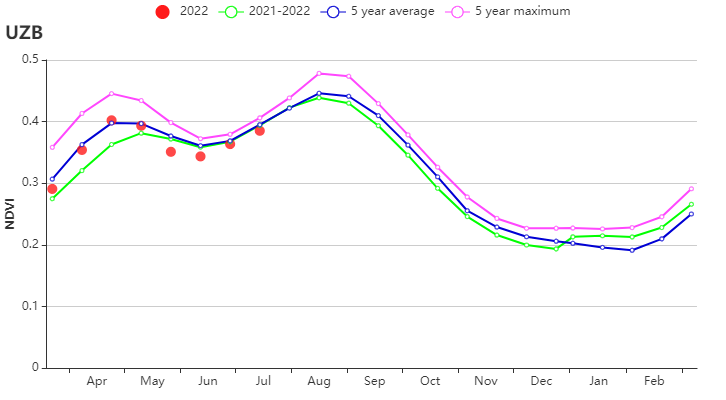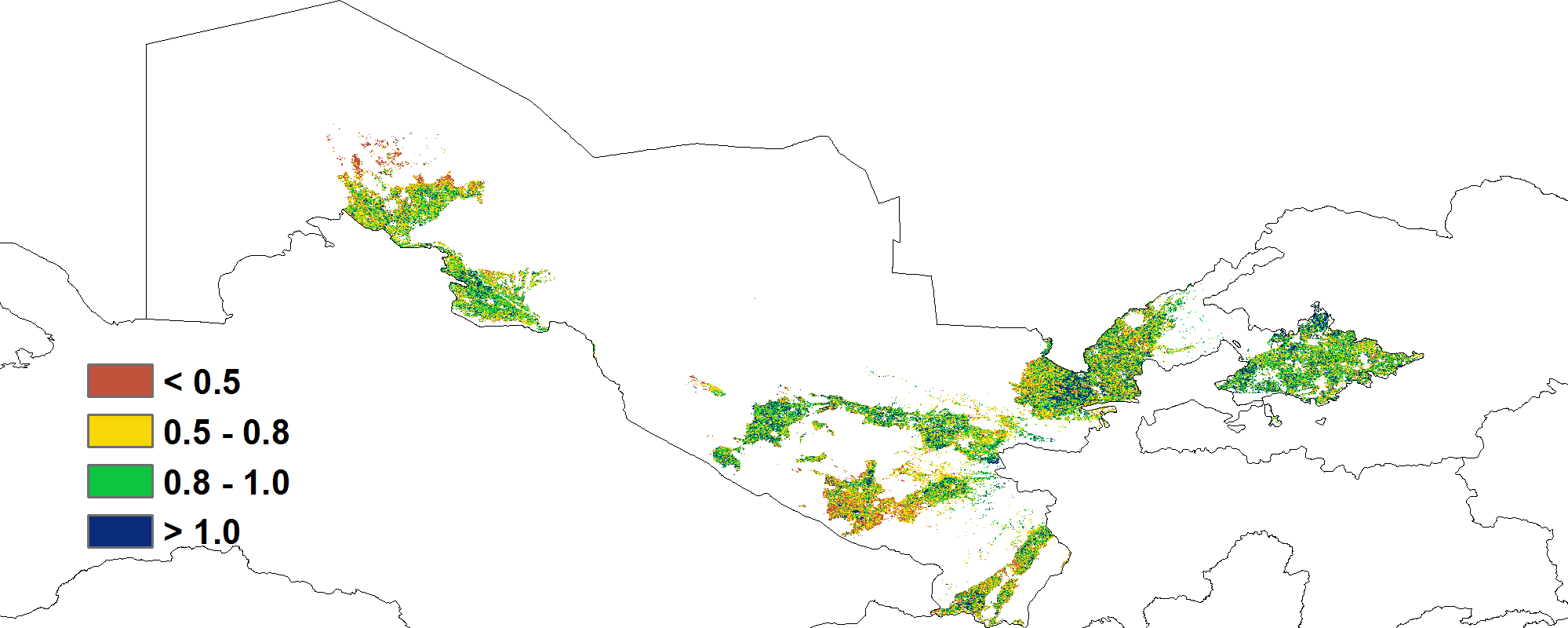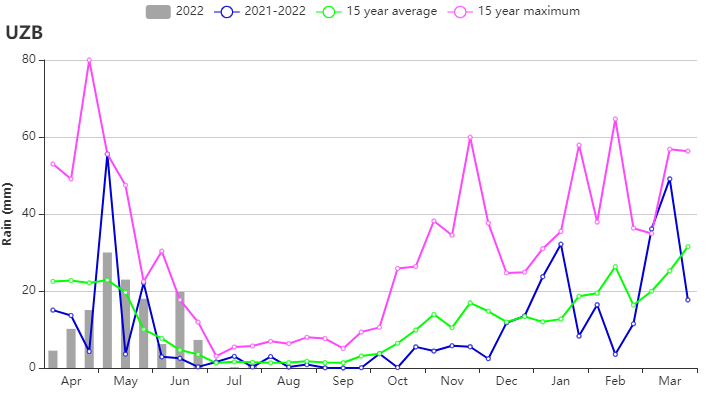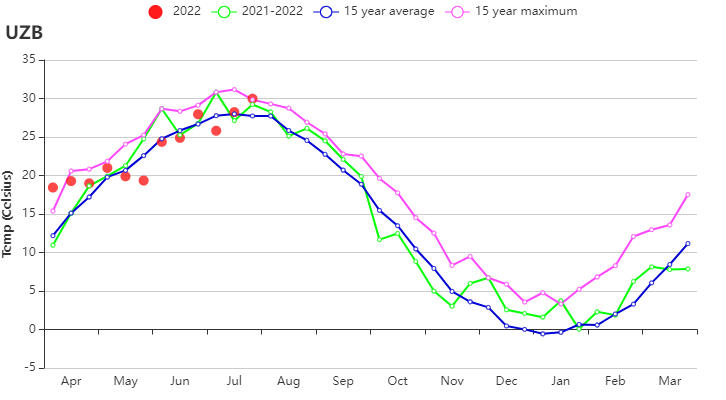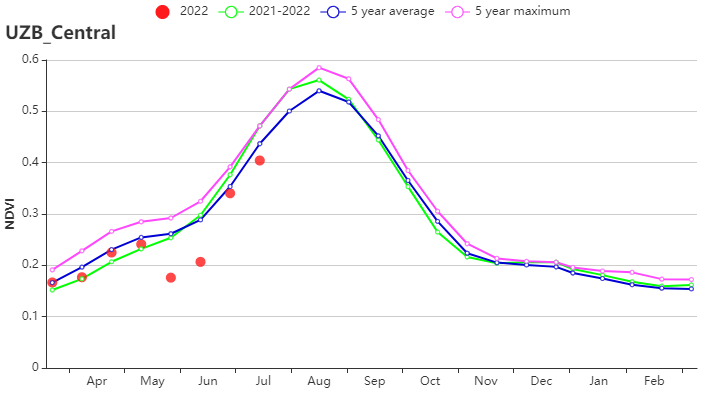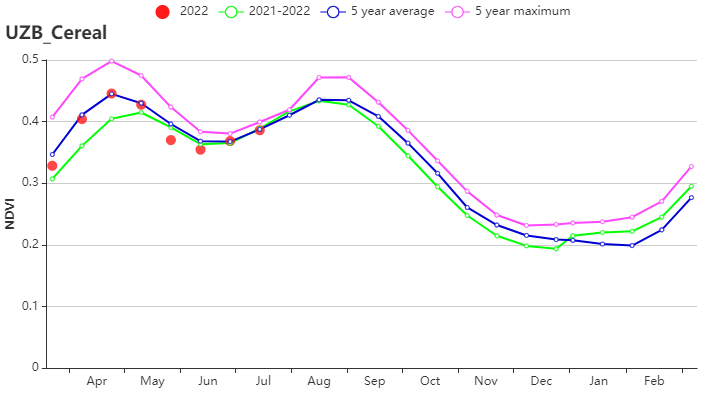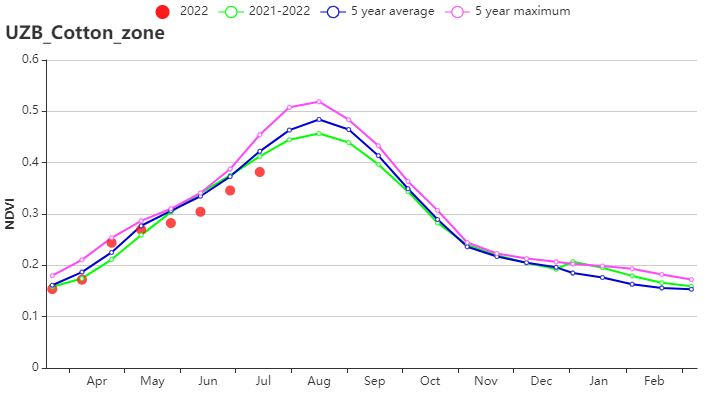This monitoring period from April to July 2022 covers the late growing period and harvest stage of winter wheat in Uzbekistan, as well as the sowing stage and early growth period of maize. The proportion of irrigated cropland in Uzbekistan is 30% and regular rainfall is crucial to sustain the growth of most crops. During this monitoring period, except for the TEMP (+0.8°C), the other agro-climate indicators were generally normal (RAIN -3%, RADPAR +0%). The NDVI development graph shows that crop conditions were near average for most of the growing period. The national VCIx was 0.80, whereas the areas with low VCIx values were mainly in the southwest of the Eastern hilly cereals zone and the northwest of the Aral Sea cotton zone. The spatial distribution of NDVI profiles also show slightly below average trends for these regions. Overall, crop conditions were close to normal.
Regional analysis
Central region with sparse crops
RAIN and RADPAR were below the 15YA, while TEMP was significantly above average (+1.3°C), and BIOMSS decreased by 1%. The regional VCIx was 0.68. The NDVI development graph shows that the crop conditions in this region were slightly below average, especially in late May and early June. This was presumably due to cloud cover in the satellite images. Crop conditions by the end of this monitoring period were slightly below average.
Eastern hilly cereals zone
RAIN was below average, while TEMP was above average (+0.8°C), and RADPAR was normal. According to the VCIx graph and the spatial distribution of NDVI profiles, the below-average crop conditions in June were caused by the poor crop conditions in Bukhoro and Kashkadarya province. The regional VCIx was 0.82, which was the highest among these three subregions. Overall crop prospects in this region are normal.
Aral Sea cotton zone
Although the farmland in this region can potentially be irrigated, lack of high quality irrigation water can limit production. High temperature is another adverse factor. Apart from the high temperature (TEMP +1.3°C), the other agro-climate indicators were basically normal (RAIN +3%, RADPAR -2%). The regional VCIx was 0.76 and CALF decreased by 10%. Crop prospects are unfavorable in this region.
Figure 3.44 Uzbekistan crop condition, April - July 2022
| |
(a) Phenology of major crops | |
|
|
(b) Crop condition development graph based on NDVI | (c) Maximum VCI |
| |
(d) Spatial NDVI patterns compared to 5YA (e) NDVI profiles | |
| |
(f) Rainfall profiles (g) Temperature profiles | |
| |
(h) Crop condition development graph based on NDVI Central region with sparse crops (left) Eastern hilly cereals region (right) | |
| |
(i) Crop condition development graph based on NDVI Aral Sea cotton region | |
Table 3.1 Uzbekistan’s agroclimatic indicators by sub-national regions, current season’s values, and departure from 15YA, April - July 2022
Region | RAIN | TEMP | RADPAR | BIOMSS | ||||
Current (mm) | Departure (%) | Current (°C) | Departure (°C) | Current (MJ/m2) | Departure (%) | Current (gDM/m2) | Departure (%) | |
Central region with sparse crops | 44 | -2 | 26.4 | 1.3 | 1530 | -2 | 600 | -1 |
Eastern hilly cereals zone | 147 | -3 | 22.8 | 0.8 | 1565 | 0 | 689 | -2 |
Aral Sea cotton zone | 27 | 3 | 26.4 | 1.3 | 1507 | -2 | 581 | 0 |
Table 3.2 Uzbekistan’s agronomic indicators by sub-national regions, current season’s values, and departure from 5YA, April - July 2022
Region | Cropped arable land fraction | Maximum VCI | |
Current (%) | Departure (%) | Current | |
Central region with sparse crops | 70 | 3 | 0.68 |
Eastern hilly cereals zone | 75 | 5 | 0.82 |
Aral Sea cotton zone | 56 | -10 | 0.76 |


